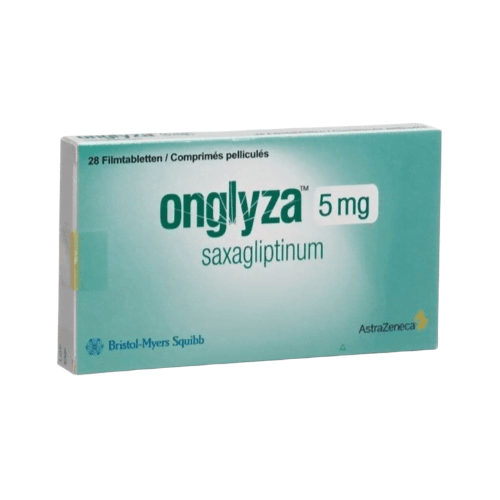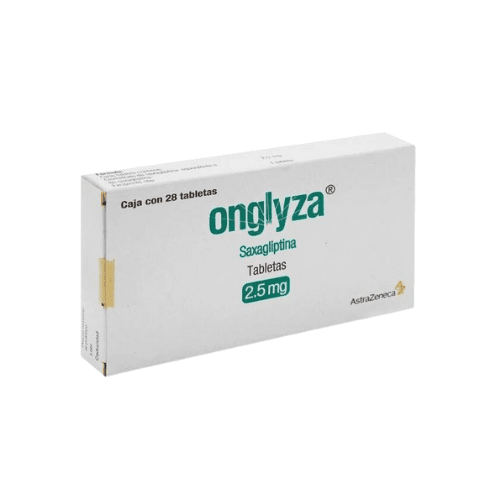Shipping with this method takes 3-5 days
Onglyza® Tablets for Type 2 Diabetes
Price range: $115.99 through $138.99
Secure Encrypted Payments
Onglyza® is a prescription DPP-4 inhibitor used with diet and exercise to help adults manage blood sugar. This page explains how it works, who it suits, and how to use it, with US shipping from Canada. It also outlines how to compare options and consider the Onglyza price without insurance.
What Onglyza Is and How It Works
YouDrugstore is a licensed Canadian pharmacy in Manitoba. Pharmacists review prescriptions before dispensing.
Onglyza® contains saxagliptin, a dipeptidyl peptidase-4 (DPP-4) inhibitor. It increases levels of incretin hormones that help your body release insulin after meals and reduce glucose made by the liver. It can be used alone or added to other oral diabetes medicines when diet and exercise are not enough.
This medicine is taken by mouth and can be used with metformin or other agents when your prescriber advises. It has a low risk of low blood sugar when used without insulin or sulfonylureas. Always use it as directed by your healthcare professional.
Who It’s For
This treatment is for adults diagnosed with T2D who need an additional oral option to support glycemic control alongside diet and regular activity. It may be used alone or with other therapies when directed by your prescriber.
People with a history of serious hypersensitivity to saxagliptin or any component should avoid this medicine. Those with pancreatitis history, significant kidney problems, or possible heart failure risk need careful evaluation. For broader context on care options, see our Type 2 Diabetes category and explore Diabetes Care resources.
Dosage and Usage
Take this medicine once daily, with or without food, at the same time each day. Swallow tablets whole with water. If your prescriber changes your regimen, follow their instructions and consult the official label for details. When combining with insulin or sulfonylureas, your prescriber may monitor you more closely for low blood sugar.
If your kidneys are not working well, your prescriber may choose a lower strength. Do not change your dose without medical advice. If you develop abdominal pain that may signal pancreatitis, contact a clinician immediately.
Strengths and Forms
This treatment is supplied as film-coated tablets in two common strengths. Availability can vary by manufacturer and packaging.
- Tablets: 2.5 mg and 5 mg
Many patients ask about saxagliptin 5 mg tablets price, but the best way to compare options is to review our current product listing and speak with your prescriber about the most appropriate strength.
Missed Dose and Timing
If you miss a dose, take it when you remember on the same day. If it is almost time for the next dose, skip the missed dose and take the next one at the usual time. Do not take two doses at once. Keeping a daily reminder or setting an alarm can help with consistent use.
Storage and Travel Basics
Store tablets at room temperature in a dry place. Keep them in the original container to protect from moisture. Do not store in a bathroom. Keep out of reach of children and pets. When traveling, carry your prescription label and enough medicine for the entire trip, plus a small buffer. Pack tablets in your carry-on to avoid lost luggage and temperature swings. Use a pill organizer only if you can keep the tablets dry. If your prescriber gives you written documentation for travel, keep it with your ID.
Benefits
This therapy is oral and taken once daily, which many people find convenient. It can be paired with other diabetes medicines when advised. It has a low risk of hypoglycemia when not used with insulin or sulfonylureas. Some patients appreciate that the treatment is generally weight neutral. Consistent use alongside healthy eating and activity can support overall metabolic goals. For additional educational reading, see our article on Diabetes Month 2025.
Side Effects and Safety
- Upper respiratory tract infection
- Headache or cough
- Nasal or throat irritation
- Gastrointestinal discomfort
- Urinary tract infection
Serious reactions are uncommon but can include pancreatitis, severe allergic reactions (angioedema, anaphylaxis), and heart failure events in susceptible patients. Stop the medicine and seek care immediately for severe abdominal pain, rash with swelling, trouble breathing, or sudden fluid retention. The risk of low blood sugar increases when used with insulin or sulfonylureas. Discuss your full medical history with a clinician before starting.
Drug Interactions and Cautions
Strong CYP3A4/5 inhibitors or inducers can affect saxagliptin levels; your prescriber may consider this when selecting therapy. Using it with insulin or sulfonylureas can raise the chance of hypoglycemia. Tell your healthcare professional about all prescription and nonprescription medicines, vitamins, and herbal products you take.
People with reduced kidney function require careful selection of strength and regular monitoring. Report symptoms that could suggest pancreatitis or heart failure. Lifestyle changes remain key; learn practical strategies in our guide on Reverse Prediabetes.
What to Expect Over Time
With regular use and lifestyle support, many people notice steadier readings over time. Your clinician may check A1C and fasting glucose to assess response. Staying on a daily schedule, refilling on time, and recording any symptoms helps your prescriber tailor your plan. Combining the treatment with nutrition counseling and activity can further support goals. For broader therapy context, see Wegovy vs Mounjaro and practical tips in Mounjaro Side Effects.
Compare With Alternatives
Other DPP-4 inhibitors may be options if your prescriber recommends a change. Linagliptin is available as Tradjenta. Sitagliptin is also used in this class; see Sitagliptin for details. Your prescriber can advise whether switching within the class or combining with metformin is appropriate based on your history, labs, and treatment goals.
Pricing and Access
We aim to make access clear and straightforward. If you want to compare saxagliptin price, check our current listing to see available pack sizes. We also outline coverage notes so you can review options with your prescriber.
Many patients ask about Onglyza cost; review our product page to see what is currently in stock and which pack sizes are listed. US Delivery is available, and orders Ships from Canada to US with careful handling. If you are looking for seasonal promotions, visit our Promotions page for current offers.
Availability and Substitutions
Supply can vary. If your preferred pack size is unavailable, your prescriber may suggest a comparable alternative. Pharmacists dispense according to your prescription, and a clinically suitable substitute may be offered when permitted. Patients sometimes research saxagliptin generic price; availability depends on jurisdiction and stock. Your clinician can indicate whether a brand or a specific manufacturer is preferred in your case.
Patient Suitability and Cost-Saving Tips
This therapy may suit adults who want an oral option, have not met targets with lifestyle measures alone, or need an add-on to existing therapy. It is not for type 1 diabetes or diabetic ketoacidosis. Tell your prescriber about kidney, pancreas, or heart concerns before starting.
Practical ways to manage costs include choosing a multi-month fill when appropriate, setting refill reminders, and reviewing formulary options with your clinician. Some patients compare Onglyza tablets price to alternatives to plan budgets. Keep your medication list up to date and bring it to appointments. For device-free regimens and supplies, explore Diabetes Care.
Questions to Ask Your Clinician
- Fit with my plan: How does this medicine align with my goals?
- Combination use: Should I pair it with metformin or another agent?
- Monitoring: Which labs and symptoms should I track at home?
- Safety: What signs suggest pancreatitis or heart failure?
- Interactions: Do any of my medicines change how it works?
- Travel: What paperwork should I carry for trips?
Authoritative Sources
Review the official information before use:
Missed Dose and Timing
If you forget a dose again, apply the same approach: take it the same day when remembered, or skip if close to the next dose. Keep a simple calendar or phone reminder to help avoid gaps.
Availability and Substitutions
If supply changes, your prescriber may recommend a comparable alternative that suits your medical history. Pharmacists will verify your prescription and dispense accordingly.
Ready to get started? Order Onglyza online with prompt US delivery from Canada, with temperature-controlled handling when required. This information is not a substitute for professional medical advice; always follow your prescriber and the official label.
Express Shipping - from $25.00
Prices:
- Dry-Packed Products $25.00
- Cold-Packed Products $35.00
Shipping Countries:
- United States (all contiguous states**)
- Worldwide (excludes some countries***)
Standard Shipping - $15.00
Shipping with this method takes 5-10 days
Prices:
- Dry-Packed Products $15.00
- Not available for Cold-Packed products
Shipping Countries:
- United States (all contiguous states**)
- Worldwide (excludes some countries***)
Is Onglyza the same as saxagliptin?
Yes. Onglyza is the brand name for saxagliptin, a DPP-4 inhibitor used to help control blood sugar in adults. The active ingredient is saxagliptin, while the brand name identifies the manufacturer’s product. Some regions may also have non-branded versions from different manufacturers. Your prescription will specify whether substitution is allowed based on your clinician’s directions and local regulations.
Can I take this with metformin?
Many adults use saxagliptin together with metformin when a single agent is not enough. The combination can be appropriate if your prescriber recommends it, and your kidney function and overall health are suitable. Some patients use fixed-dose combinations prescribed by their clinician. Do not change your regimen without guidance, and report any new symptoms such as abdominal pain or signs of low blood sugar.
Does this medicine cause weight gain?
DPP-4 inhibitors are generally considered weight neutral. Onglyza is not typically associated with significant weight gain when used alone. However, overall weight can change due to diet, activity levels, and other medicines. If you use it with insulin or a sulfonylurea, you may have a higher chance of low blood sugar, which can influence eating patterns. Discuss goals and monitoring with your clinician.
How long before I notice effects?
People often notice steadier glucose readings over time with consistent daily use and lifestyle measures. Your clinician will check A1C and other markers at follow-up visits to assess response. Avoid changing your dose on your own. Keep a log of readings, meals, and any symptoms, and share this information during appointments to help guide your plan.
What if I have kidney problems?
Kidney function affects how saxagliptin is handled by the body. Your prescriber may select a different strength or a different therapy based on lab values and your medical history. Report swelling, shortness of breath, or persistent abdominal pain promptly. Do not adjust your dose without medical advice, and consult the official label for current guidance.
Is a generic available?
Availability of non-branded saxagliptin varies by region and over time. Your pharmacy will follow the prescription and local substitution rules. Ask your prescriber whether a brand or a particular manufacturer is preferred for you. If a non-branded option is suitable and stocked, your pharmacist can discuss how it compares to the brand in terms of active ingredient and use.
Can I split the tablets?
The tablets are film-coated and not designed to be split or crushed. Splitting may affect how the medicine is delivered. If you have trouble swallowing tablets, talk with your clinician about alternatives or administration tips. Never alter tablets before confirming with a healthcare professional, and always follow the instructions on your prescription label.

